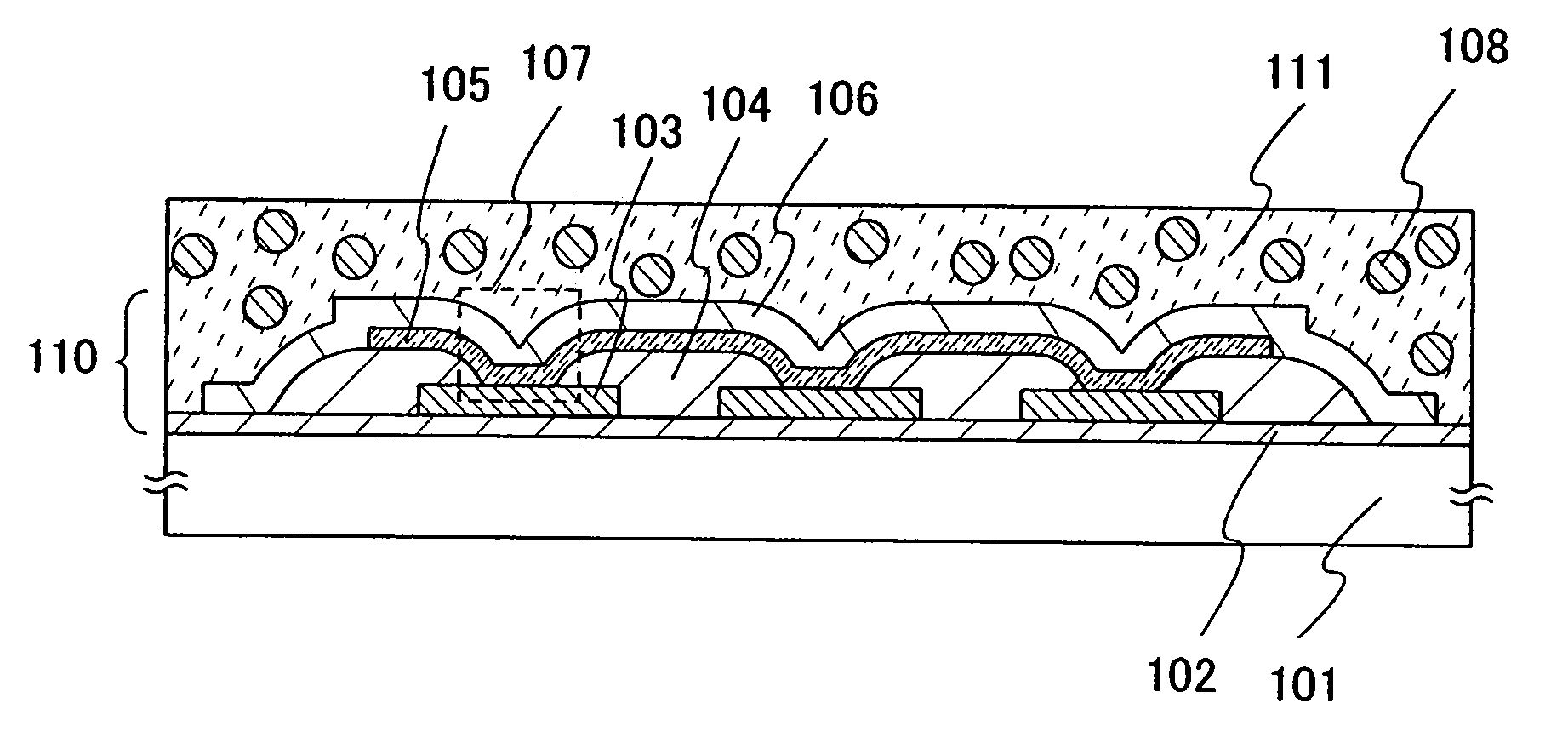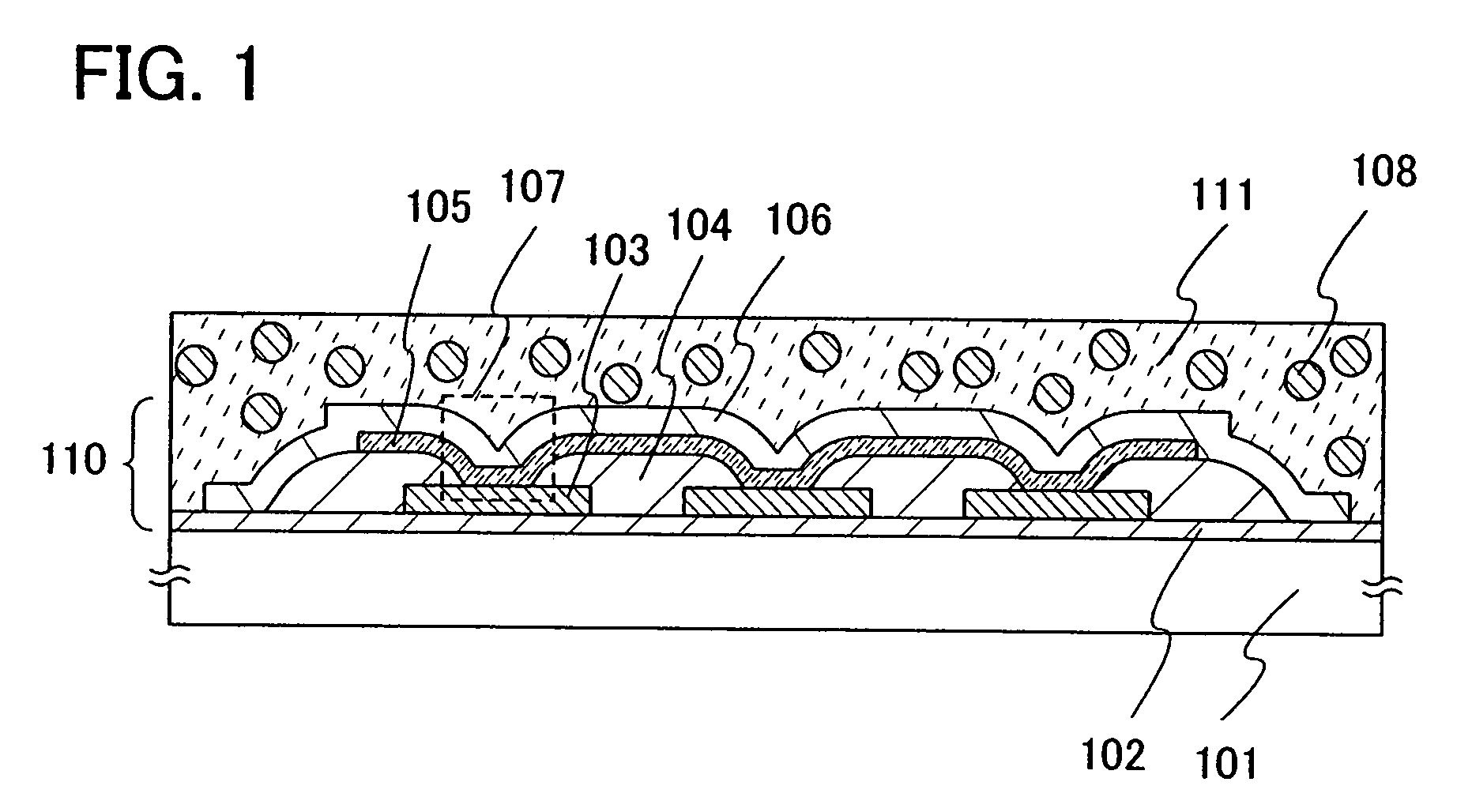Memory device and semiconductor device
- Summary
- Abstract
- Description
- Claims
- Application Information
AI Technical Summary
Benefits of technology
Problems solved by technology
Method used
Image
Examples
embodiment mode 1
[0035]In this embodiment mode, a main structure of a memory device of the present invention will be described. Typically, a memory device having a memory cell in which a memory element is provided will be explained with reference to FIG. 1, FIGS. 2A to 2C and FIGS. 4A to 4C. Note that each memory element has a layer including an organic compound between a pair of electrodes formed of a first electrode layer and a second electrode layer, and the memory cell are arrange in matrix in the memory device. Also, a structure of the memory element will be explained with reference to FIGS. 3A to 3F.
[0036]As shown in FIG. 4A, a memory device 127 has a memory cell array 132 and a driving circuit to drive the memory cell array. In the memory cell array 132, the memory cells 21 are provided in matrix. The memory cell 21 has a memory element 107 (see FIG. 1). The memory element 107 has the first electrode layer 103 extending in a first direction, a layer 105 including an organic compound which cov...
embodiment mode 2
[0119]In this embodiment mode, in the memory device shown in the above embodiment mode, a main structure of a memory device having a memory cell array where memory cells each have a switching element and a memory element will be explained using FIG. 5 and FIGS. 6A to 6C. FIG. 5 is a cross sectional view of the memory device in this embodiment mode, and FIGS. 6A to 6C illustrate a structure of the memory device in this embodiment mode.
[0120]Note that the mode shown in FIG. 5 is a deformed example of the mode shown in FIG. 2C, and a mode where the element layer and the sealing layer are sealed with the flexible substrate is shown. In the mode shown in FIG. 5, the switching element and the memory element is formed in the element layer of the memory device shown in FIG. 1, FIGS. 2A and 2B.
[0121]As shown in FIG. 6A, a memory device 221 in this embodiment mode has a memory cell array 222 and a driver circuit which drives the memory cell array 222. The memory cell array 222 has a plurality...
embodiment mode 3
[0142]In this embodiment mode, one mode of a semiconductor device which is formed by the peeling method shown in the above embodiment mode will be described below. Typically, a main structure of a semiconductor device which can perform transmission / reception of instructions or data with radio signals will be explained with reference to FIG. 7 and FIG. 8. FIG. 7 is a cross sectional view of the semiconductor device in this embodiment mode. FIG. 8 illustrates a structure of the semiconductor device in this embodiment mode. Note that the semiconductor device in this embodiment mode has a memory portion including the memory cell array shown in the above embodiment mode.
[0143]FIG. 8 is a block diagram illustrating a structural example of the semiconductor device which can perform transmission / reception of instructions or data with radio signals. Such a semiconductor device includes an antenna 312, an RF circuit portion 313, a power supply circuit portion 315, and a logic circuit portion ...
PUM
 Login to View More
Login to View More Abstract
Description
Claims
Application Information
 Login to View More
Login to View More - R&D
- Intellectual Property
- Life Sciences
- Materials
- Tech Scout
- Unparalleled Data Quality
- Higher Quality Content
- 60% Fewer Hallucinations
Browse by: Latest US Patents, China's latest patents, Technical Efficacy Thesaurus, Application Domain, Technology Topic, Popular Technical Reports.
© 2025 PatSnap. All rights reserved.Legal|Privacy policy|Modern Slavery Act Transparency Statement|Sitemap|About US| Contact US: help@patsnap.com



